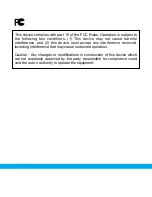
Skytech: RCT-MLT-IV
REV. 3-26-19 Page 6
TROUBLE SHOOTING
If you encounter problems with your fireplace system, the problem may be with either the fireplace itself or with the remote. Review
the fireplace manufacturer’s operation manual to make sure all connections are properly made. Then check the operation of the
remote in the following manner:
•
Make sure all batteries are correctly installed in the transmitter. Also check that the batteries are fully charged.
•
Check batteries in transmitter to make sure contacts are touching (+) and (-) ends of battery. Bend metal contacts in for tighter fit.
•
Be sure receiver and transmitter are within 20 to 25-foot operating range.
•
Keep receiver from temperatures exceeding 170º F.
•
If receiver is installed in a tightly enclosed metal surrounding, the operating distance will be shortened.
•
Make sure the hand-held transmitter and remote receiver are communicating properly (see LEARNING TRANSMITTER TO
RECEIVER section).
FCC REQUIREMENTS
NOTE: THE MANUFACTURER IS NOT RESPONSIBLE FOR ANY RADIO OR TV INTERFERENCE CAUSED BY UNAUTHORIZED
MODIFICATIONS TO THE EQUIPMENT. SUCH MODIFICATIONS COULD VOID USER’S AUTHORITY TO OPERATE THE EQUIPMENT.
FOR TECHNICAL SERVICE, CALL:
Skytech
9230 Conservation Way
Fort Wayne, IN 46809
(855) 498-8324
Fax (888) 431-0585
For Sales: (888) 672-8929
WEB SITE
: www.skytechpg.com
FCC Notification
Note:
This equipment has been tested and found to comply with limits for a Class B digital device, pursuant to part 15 of
the FCC Rules. These limits are designed to provide reasonable protection against harmful interference in a residential
installation. This equipment generates, uses and can radiate radio frequency energy and, if not installed and used in
accordance with the instructions, may cause harmful interference to radio communications. However, there is no
guarantee that inference will not occur in a particular installation. If this equipment does cause harmful interference to
radio or
television reception, which can be determined by turning the equipment off and on, the user is encouraged to try to correct
the interference by one or more of the following measures:
•
Reorient or relocate the receiving antenna
•
Increase the separation between the equipment and the receiver
•
Connect the equipment into an outlet on a circuit different from that to which the receiver is connected
•
Consult the dealer or an experience radio/TV technician for help


























